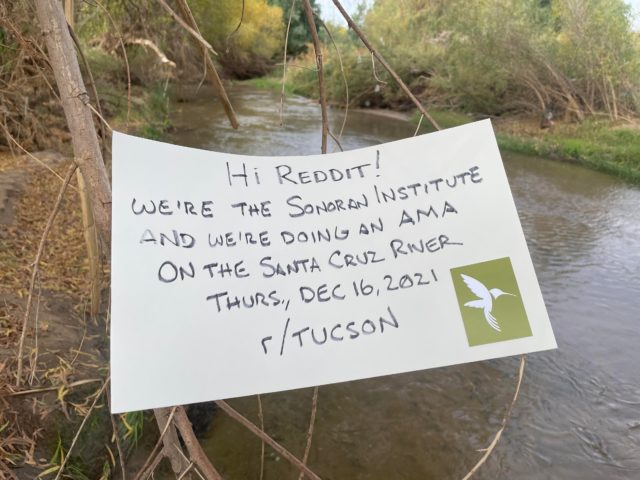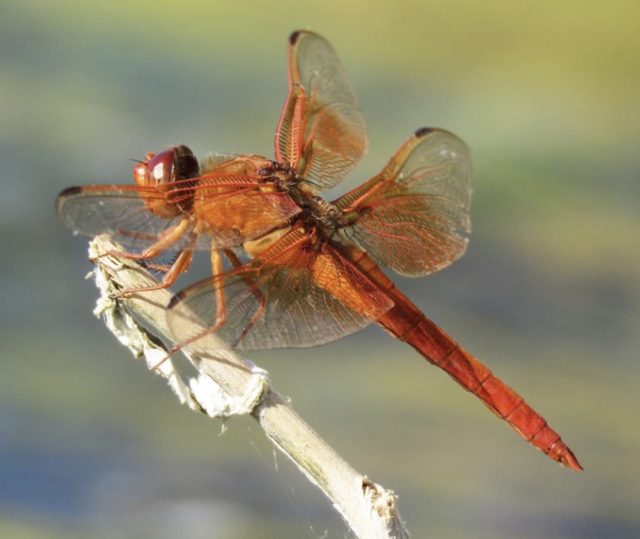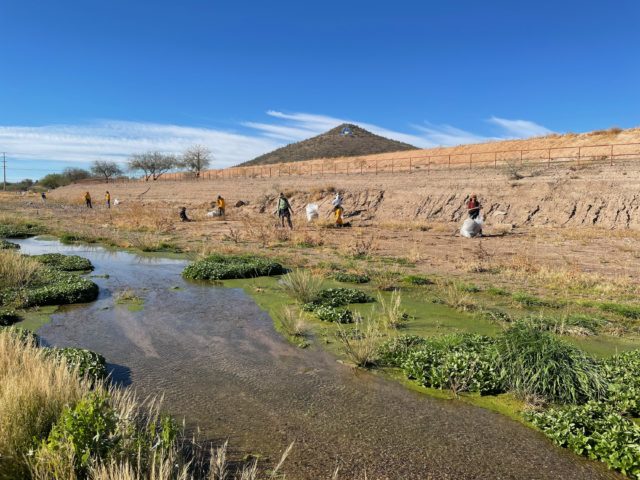Last month our Santa Cruz River team was invited to do an Ask Me Anything on the Tucson subreddit. The online group is focused on Tucson-specific issues and news and has more than 53,000 members. The message board is a resource for people who live in the Old Pueblo, newcomers, and people considering a visit or homesick for one.
 Claire Zugmeyer, ecologist, Luke Cole, associate director, and the marketing team got together in Claire’s backyard to compose answers on a chilly winter afternoon. The questions asked by community members were inquisitive and informed, and we enjoyed learning about what is important to a group of folks that we haven’t interacted with before. Here’s a short recap, but feel free to browse the original thread.
Claire Zugmeyer, ecologist, Luke Cole, associate director, and the marketing team got together in Claire’s backyard to compose answers on a chilly winter afternoon. The questions asked by community members were inquisitive and informed, and we enjoyed learning about what is important to a group of folks that we haven’t interacted with before. Here’s a short recap, but feel free to browse the original thread.
Recreation
What are the best parts for recreation?
- The Loop!
- El Rio Preserve for birdwatching
- Crossroads Park at Silverbell has slightly hidden, but good access to the flowing river. Be smart, never walk in a storm drain with any chance of rain.
- Tumacácori National Historic Park and the De Anza Trail between the park and Tubac.
- The headwaters in San Rafael Valley are composed of a lot of private land but make for a nice scenic drive.
Wildlife
What types of animals use the area the most? Anything endangered? Will they benefit from the changes or are there concerns?

by Michael T. Bogan. Instagram: @deserth2o
80% of wildlife uses riparian areas during their lifetime. Bobcats, coyotes, javelina, hawks and birds, dragonflies, bugs, roadrunners, fish, coati, bats, ocelots, lizards, snakes. Gila topminnows are endangered and present in the Santa Cruz River. We see positive opportunities with dedicated, high-quality water for all wildlife.
Effluent quality and schedule
What “schedule” are you hoping to maintain in terms of what times of year the Santa Cruz will have water?
We have year-round releases of water because the treatment plants operate 24/7 and water is released continuously. Our goal is to increase the miles of flowing river and to keep the water we currently have.
How safe is reclaimed water for people to consume?
Reclaimed water in the Santa Cruz River is not treated to drinking water standards and should not be consumed. However, it is possible to treat water to potable standards.
Concerns
What are the major considerations when balancing accessibility by humans and use for recreation vs trying to keep it a good environment?
It always takes a balance. In more urban areas the channel is narrow, so we look for a balance between habitat and flood safety. Other considerations are flash flooding, natural vegetation, and community wishes.
How real is the “concern” that trees will grow and be a problem if the river were to run all year around?
Trees growing in the river only present a problem in areas where the river flows through narrow corridors, like the downtown area. In narrow areas we have to balance flood safety with habitat.
I’ve heard that another issue with having the river run full-time is that there was a landfill, and its contaminants will poison the aquifer… Do you consider this a true threat? Is there anything that can be done about it?
Having water in the river year-round is positive, but the amount of water is being monitored to prevent groundwater levels from rising to the depth of the landfills. If water enters the landfills the contamination would lead to problems for our water supply. The landfills could be removed, but this is an expensive process. Tucson Water is being proactive by monitoring this carefully.

How big of an issue is trash? What are the other main sources of pollution?
It’s big! Our community has long brought up trash as something they want to see addressed in the river channel. Stakeholder meetings held in 2019 and 2020 with Pima County Regional Flood Control District consistently tread on the recurring question: can anything be done about the trash? We are surveying trash to learn its magnitude, composition, and sources.
Read more on our Santa Cruz River Trash Reports.
Is there any relevant legislation that you actively fight for/against we should know about?
People should be aware of a new Arizona statute that says the Santa Cruz River is a waterbody that will be protected by state law. Additionally, the state recently released a list of impaired waterbodies for the EPA that are not meeting water quality standards and are accepting public comment. The Santa Cruz is on the list for a few sites that are high in E. coli and nitrogen. The Army Corps of Engineers and EPA have published a proposed rule defining the scope of waters protected under the Clean Water Act. Comments are due February 7, 2022.
You can always reach out to your local government representatives and voice your support for more clean water in our rivers.
The past and future
How has the size and path of the Santa Cruz changed over time? Was there more water in the Santa Cruz or other local rivers before large settlements popped up in Tucson? What is the highest the river gets annually now, and how does that compare to historical peaks?
There are a lot of ways this could be answered depending on how far back you go, or which reach of the river you talk about. In Tucson, the floodplain of the river was wider in the past, before urban development. With the growth of the city the river channel was narrowed. Current flow data for the Santa Cruz River can be found here.
Historically the river has changed in different ways. We used to have year-round water in many places, but with the pumping of groundwater some reaches dried. The floodplain was historically wider but has been narrowed with urban development.
You can learn about how the river has changed in our State of the Santa Cruz River publication.
I have heard that Tucson used to have quite a few year-round rivers and marshy areas before the water table fell. Is that true? What happened? What’s the prediction for what the future will look like? Will we ever get bone dry, or could we recover a bit?
This article from the Water Resource Research Center with the University of Arizona goes in depth about water use in the Tucson area, beyond just the Santa Cruz River.
Water use went up in the midcentury as we began pulling more groundwater in response to urban growth. The city successfully stopped the dangerous rate of pull from the aquifer and has since been carefully managing groundwater. We’re optimistic about the future because water issues are being taken seriously and communities, states and nations are becoming more cooperative to address the challenges, from the local and regional level with programs like Growing Water Smart to international agreements on the Colorado River.
Tacos Win
And of course, our most contentious question of the night… Sonoran hot dogs or tacos?
Our team has 1 vote for veggie Sonoran dogs, 3 for tacos, and one for the Sonoran hot dog taco at Boca Tacos. [Claire’s daughter also cast a vote on this one.]
Read the rest of the AMA.
For those looking to help: get involved in trash clean-up days and sign up for our Santa Cruz River e-mail list for news and events.
Blog post by Kashja Iler, marketing intern and Corinne Matesich, marketing manager.
